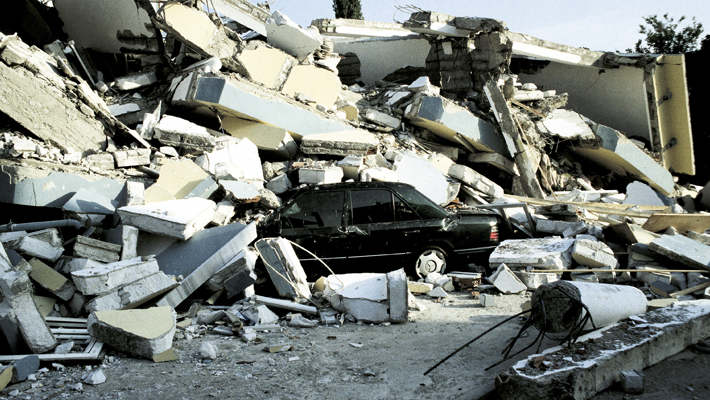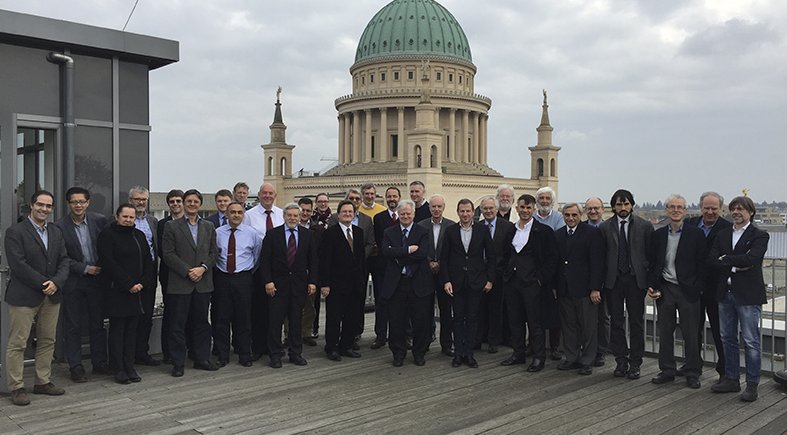20.03.2017: Depending on the magnitude earthquakes can cause severe damage to buildings leading even to total collapse. This leads to the loss of thousands of lives every year. In order to reduce this risk scientists are working on building regulations that shall contribute to rendering houses and buildings more resilient to seismic shocks. On March 16th and 17th, experts from all over Europe got together in Potsdam to discuss how the current building regulations can be adapted to the current state of research and, consequently, be update and improved.
Prof. Fabrice Cotton and Prof. Gottfried Grünthal from the GFZ German Research Centre for Geosciences, Section Seismic Hazard and Stress Field hosted the meeting. Cotton and Grünthal have been working for years on “Earthquake Building Standards” as active members of the DIN-Standard Committee, the German regulatory committee for all kind of norms. Cotton is also active in European working groups which develop corresponding regulations at a European level (European building codes EC8). The title of the two-day event was “Eurocode 8; Earthquake Resistance Design of Structures”.
Earthquake catalogs provide useful information
“Usually, houses are constructed in such a way that they can primarily withstand vertical loads, such as a converted attic”, says Cotton. “An earthquake, however, also exerts horizontal stress on the building. Without technical precautions it will be damaged or can even quickly collapse.” Hence, engineers have developed several design techniques in order to prevent strong damage. These include, for example, a support cross such as those found on bookshelves or special vibration dampers.
Such measures, however, are expensive. Therefore, building regulations are determined according to the seismic hazard in a respective region. Important parameters are maximum magnitude and recurrence intervals of Earthquakes in various magnitude classes. Earthquake catalogs for Germany and Europe that were developed by Grünthal and colleagues provide data for every region. “We have documented historical and paleoseismological data”, says Grünthal. “In order to get a grasp of the uncertainties we have used sophisticated statistical algorithms.”
With regard to Germany the scientists found remarkable catchy recurrence intervals: Earthquakes with a magnitude of more than 3.5 occur, on average, once a year, earthquakes with magnitudes of 4.5 and greater every ten years on average and with a magnitude above 5.5 every hundred years. The region of the Lower Rhine (Niederrhein) is considered a region with a higher seismic hazard. “Paleoseismological studies have shown an earthquake with a magnitude of approx. 6.7”, says Grünthal. “Theoretically, magnitudes of more than 7 could be expected in this area, however, with a very low probability of occurrence.”
Soft soil is stronger affected by seismic waves
In addition to the physical parameters of earthquakes, the ground motion near the building sites also plays an important role. “Soft soil is stronger affected by seismic waves than a stiff rocky ground”, Cotton explains. “This field of research is relatively young. Experimental data (e.g. seismological records close to major earthquakes) have only just been collected and will be included in the considerations.”
It is essential to now merge all the existing scientific results and knowledge as the new building regulations should be easy to apply for civil engineers. "It means simple, effective and robust", says Cotton. The meeting in Potsdam has made an important contribution in this respect. (rn)









![[Translate to English:] Torsten Sachs in front of a climate station on a field](/fileadmin/_processed_/3/9/csm__TorstenSachs_bearbeitet_GS_4a1365ef84.jpeg)

![[Translate to English:] left image flood at the Ahrtal: image from above, several houses are flooded; left image:: Heidi Kreibich;](/fileadmin/_processed_/4/4/csm_Bild2_9af0130e9f.png)



![[Translate to English:] Start der Vega Rakete](/fileadmin/_processed_/6/4/csm_20231201-kachel_Vega-VV23-launch_ESA-CNES-Arianespace_706716b68c.jpeg)









![[Translate to English:] Poster exhibition at the Brandenburg Hydrogen Day at the GFZ, some participants in the foreground](/fileadmin/_processed_/6/5/csm_Erster_Brandenburgischer_Wasserstofftag_GFZ_402fcec95e.jpeg)
![[Translate to English:] Group picture of the participants](/fileadmin/_processed_/9/4/csm_20231108_CAWa-Workshop-Tashkent_Gruppenbild_99ea779d8a.jpeg)

![[Translate to English:] [Translate to English:] Hörsaal](/fileadmin/_processed_/e/6/csm_H%C3%B6rsal_e21ac645fb.jpeg)


![[Translate to English:] The Delegations in the Historic Library on the Telegrafenberg. In the back there are from left to right, the Dutch Ambassador for Germany, Ronald van Roeden, the Dutch Minister for Education, Culture and Science, Robbert Dijkgraaf and the scientific director of the GFZ, Susanne Buiter.](/fileadmin/_processed_/d/b/csm_Kachel-2_9eba4b4212.jpeg)

